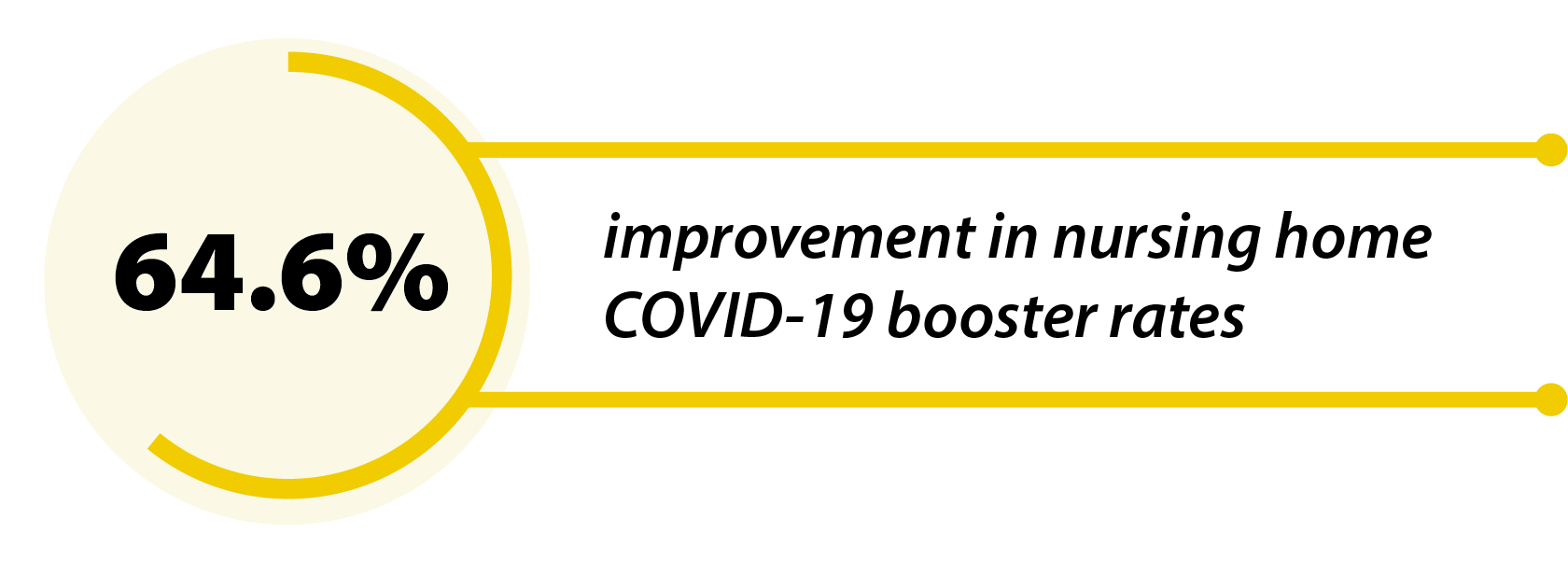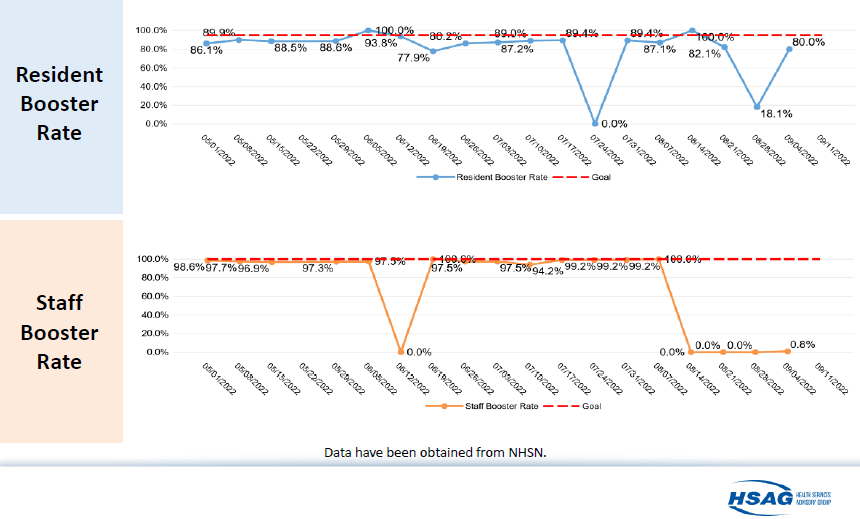 Health Services Advisory Group (HSAG), a Centers for Medicare & Medicaid Services (CMS) Quality Innovation Network–Quality Improvement Organization (QIN-QIO) helped more than 634 nursing homes in its two-state region improve the accuracy of their COVID-19 vaccine data in the Centers for Disease Control and Prevention (CDC) National Healthcare Safety Network (NHSN). With HSAG’s assistance, the nursing homes collectively improved their COVID-19 resident booster rate by 64.6 percent from when they were first referred to HSAG through September 19, 2022.
Health Services Advisory Group (HSAG), a Centers for Medicare & Medicaid Services (CMS) Quality Innovation Network–Quality Improvement Organization (QIN-QIO) helped more than 634 nursing homes in its two-state region improve the accuracy of their COVID-19 vaccine data in the Centers for Disease Control and Prevention (CDC) National Healthcare Safety Network (NHSN). With HSAG’s assistance, the nursing homes collectively improved their COVID-19 resident booster rate by 64.6 percent from when they were first referred to HSAG through September 19, 2022.
Prioritizing Assistance
As a QIN-QIO, HSAG works with more than 1,300 nursing homes to improve their quality measure ratings on clinical measures for resident care, reducing the spread of COVID-19 and encouraging COVID-19 vaccine and booster uptake among staff and residents. HSAG identifies CMS-referred nursing homes needing assistance with NHSN data entry by prioritizing those that have COVID-19 resident booster rates of less than 20 percent. An abrupt decrease to less than 20 percent can be a red flag for data collection errors. Staffing shortages and turnover, access to NHSN and statewide immunization registries, inconsistent data collection and tracking and limited resources can all contribute to low resident booster rates.
Focusing on Education
HSAG offers a three-pronged strategy to help nursing homes that includes educational opportunities, one-on-one assistance, and COVID-19 Vaccine Trend Reports. The QIN-QIO encourages participation in all CDC NHSN trainings, as well as HSAG’s weekly NHSN office hours calls that are regularly attended by 50–70 nursing homes and provide an open forum for facilities to ask questions of HSAG and their peers. To date, more than 1,000 participants representing 489 nursing homes have attended these office hours. HSAG also hosts California nursing home infection prevention webinars and Arizona COVID-19 care coordination post-acute care webinars. Since January 2022, HSAG hosted 61 of these webinars with 20,792 attendees.
Offering One-On-One Assistance
If a nursing home exhibits low vaccine or booster rates, HSAG may find that the nursing home doesn’t have an internal data tracking form. In this instance, HSAG recommends the use of NHSN’s event level form because it allows the nursing home to track data at the facility level. As long as the nursing home has access to NHSN and is using the event level form, its data will be available even when the nursing home experiences staff turnover. HSAG provides one-on-one support to assist with enrollment and access to NHSN and orientation to NHSN modules, including training on surveillance definitions, weekly reporting, and how to correct erroneous data errors from previous weeks.
Setting Improvement Goals Using Data
HSAG provides weekly COVID-19 Vaccine Trend Reports that nursing homes access through HSAG’s Quality Improvement and Innovation Portal. Examples of HSAG COVID-19 Trend Reports shown below were presented during a QIN-QIO Community of Practice Call.


These reports use exported NHSN data to populate case and death counts in addition to the vaccine data and provide both resident and staff booster rate data and improvement goals and have become a sought-after resource by nursing home senior leadership.
Keys to Success
HSAG has strong relationships with its state and local health departments. The QIN-QIO is actively involved in statewide calls and meetings and is seen as a reliable and accessible source for information and assistance in the community. HSAG stays abreast of all NHSN updates and is known as the NHSN expert in the states it serves.
HSAG also created a group in NHSN to which more than 1,000 nursing homes conferred rights. This allows the QIN-QIO to review data in real time for any facility that is in the group. HSAG can also see which NHSN users are associated with a particular facility, so the QIN-QIO knows exactly who to reach out to regarding data issues. In addition, HSAG can validate data corrections as soon as they are made.
All nursing homes in the region served by HSAG that were referred to the QIN-QIO for assistance between January 9 and October 2, 2022, saw a 17 percent net increase in resident vaccination/booster rates as compared to nursing homes in that region that were not referred to the QIN-QIO for assistance. In addition, the percentage of fully vaccinated and boosted residents in HSAG’s nursing homes two-state region referred to the QIN-QIO for assistance increased by 31 percent compared to fully vaccinated and boosted residents in nursing homes not referred to the QIN-QIO, which increased by only 6 percent.
HSAG’s Regional Nursing Home Resident COVID-19 Vaccination/Booster Rates Including Referral from January 9 through October 2, 2022.
The graph compares vaccination rates of CMS-referred facilities (orange) with never-referred facilities (blue) and only includes referrals made between January 9 and October 2, 2022. Never-referred facilities did not meet initial criteria for booster referral because CMS focused on facilities with significantly lower rates.
This material was prepared by The Bizzell Group (Bizzell), the Data Validation and Administrative (DVA) contractor, under contract with the Centers for Medicare & Medicaid Services (CMS), an agency of the U.S. Department of Health and Human Services (HHS). Views expressed in this material do not necessarily reflect the official views or policy of CMS or HHS, and any reference to a specific product or entity herein does not constitute endorsement of that product or entity by CMS or HHS. 12SOW/Bizzell/DVA-1114-07/18/2023

